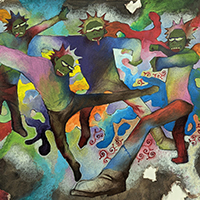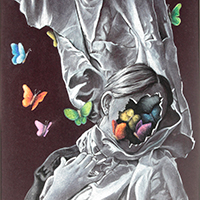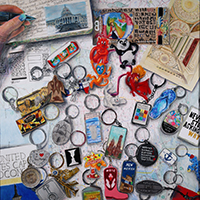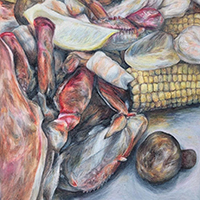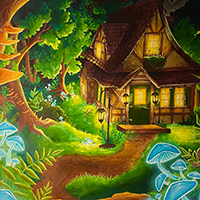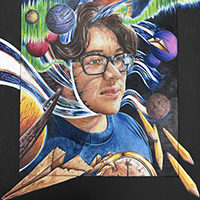Advocate
It's imperative that we all do our part to advocate for Art Education and the Fine Arts. Use these resources to give you ideas on how you can advocate for your program and how to let others know how important art education and the Fine Arts are for a well-rounded curriculum.
Big Art Day
Big Art Day is an art happening to raise awareness of art education and art as a creative force in our communities on a BIG statewide scale. It is an attempt by the Texas Art Education Association (TAEA) to engage all art educators, their students and communities in a single day art event.
District of Distinction
District of Distinction is an annual recognition program created by Texas Art Education Association and run by the Administration and Supervision division to honor school districts that are leading the way in the visual arts.
Scholarships
TAEF fosters and rewards careers in art education through the awarding of scholarships to higher education students engaged in art education programs.
Awards
TAEA strives to honor our hard working membership through recognition of their continued efforts and significant achievements in art education at the local, state, regional, and national level.
Texas Cultural Trust
The Texas Cultural Trust manages various programs to heighten awareness and support for the arts as essential to improving public education and stimulating economic growth, including Art Can, Texas Medal of Arts Awards, Texas Young Masters, Texas Women for the Arts, Arts Access, and Partners in the Arts.
TAEA Advocacy Pamphlet
Download TAEA's pamphlet on art advocacy for lessons the arts teach, an advocacy toolbox, and more!
Art Advocacy Web Links
Check out a list of websites TAEA has put together to learn more about Art Advocacy.
Art Advocacy Toolkit
Check out a list of ideas for how to advocate for your art program.
Social Media Hashtags
Knowing how to use hashtags and images will help boost your social media engagement.
Art Todays Brain Food
Listen to Dr. Cindy Todd explain why the arts are a necessity for K-12 education.
Be an Art Advocate! Act Now!
Megan Tchokoev, TAEA Advocacy Chair
Advocacy is public support for a particular cause. In visual arts education it seems as we are always working on this concept of advocacy. Why is that? The reason I see is that as educators we are working to advance our mission, our programs, and our outreach for greater student understanding, learning and passion for our discipline. In order to support rich programming, our communities and stakeholders have to support what we do daily. Every art educator, regardless if this is your first year or fortieth year in our profession should work to advocate for visual arts – subscribe to the mantra of "leaving it better than you found it." As you advocate keep in mind the three "basics" of advocacy shared by NAEA and TAEA:
Communicate a CLEAR message. Show "why is what you do in visual arts important?" and be sure to include data whenever possible.
Be VISIBLE. Make a plan for your advocacy efforts and get outside your room/school walls with your message. Think about events you can showcase what happens in your space to the broader community.
Activate an Advocacy NETWORK. Identify committed people and help them get involved. Make sure the message is communicated clearly and all stakeholders are part of the greater vision and purpose.
Want to know more and be better informed? Check out our resources with our partner at the National Art Education Association (NAEA) along with Texas Art Education Association programming like Be Visual, Big Art Day and our TAEA Advocacy Toolkit!
Ten Lessons the Arts Teach
By Elliot Eisner
- The arts teach children to make good judgments about qualitative relationships. Unlike much of the curriculum in which correct answers and rules prevail, in the arts, it is judgment rather than rules that prevail.
- The arts teach children that problems can have more than one solution and that questions can have more than one answer.
- The arts celebrate multiple perspectives. One of their large lessons is that there are many ways to see and interpret the world.
- The arts teach children that in complex forms of problem solving purposes are seldom fixed, but change with circumstance and opportunity. Learning in the arts requires the ability and a willingness to surrender to the unanticipated possibilities of the work as it unfolds.
- The arts make vivid the fact that neither words in their literal form nor number exhaust what we can know. The limits of our language do not define the limits of our cognition.
- The arts teach students that small differences can have large effects. The arts traffic in subtleties.
- The arts teach students to think through and within a material. All art forms employ some means through which images become real.
- The arts help children learn to say what cannot be said. When children are invited to disclose what a work of art helps them feel, they must reach into their poetic capacities to find the words that will do the job.
- The arts enable us to have experience we can have from no other source and through such experience to discover the range and variety of what we are capable of feeling.
- The arts' position in the school curriculum symbolizes to the young what adults believe is important.
SOURCE: Eisner, E. (2002). The Arts and the Creation of Mind, In Chapter 4, What the Arts Teach and How It Shows. (pp. 70-92). Yale University Press. Available from NAEA Publications.
Additional TALKING POINTS for letters to your local officials, representatives, and those influential voices in your community
- A student has to have 26 credits to graduate under the recommended plan (this may vary by school district as the school board has some say in credits). 7 of those credits are electives. For most high schools, the majority of electives offered are actually CTE courses so the probability is pretty high that a student already takes a credit of CTE. A win-win scenario would be to change the wording from "or" to "and" so a student has to have a credit in both Fine Arts and CTE to graduate.
- Our society inherently places a strong emphasis on visual communication.
- Previous legislation recognized the importance of Fine Arts to a well-rounded curriculum.
- Craftsmanship is emphasized in all Fine Art courses and helps a student develop skills necessary for any trade.
- There is a strong correlation between a person's emotional well-being and their connection to the Fine Arts.
- Share with officials a heartwarming story of how taking art had a positive impact on that student.
Here are some additional articles and pamphlets with useful data and facts:
- Texas Arts Education Campaign (txartsed.org)
- New evidence of the benefits of arts education (brookings.edu)
- The Arts and Achievement in At-Risk Youth: Findings from Four Longitudinal Studies
- The Arts Make a Difference in Academic Success! - St Petersburg Arts Alliance (stpeteartsalliance.org)
- Arts Education and Positive Youth Development
- Arts Education Matters: We Know, We Measured It (Opinion) (edweek.org)
- AFTA-Arts-Education-Navigator-Facts-Figures.pdf (miarted.org)
- No Bleed Visual Arts & Academics Advocacy Brochure (faea.org)
Highlights from 2023-2024 Student Programs
Click any image to see more information about the artwork.











